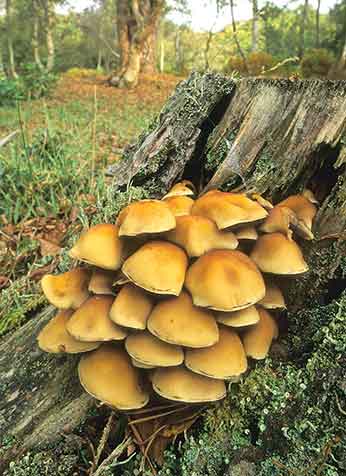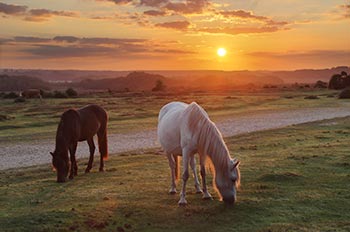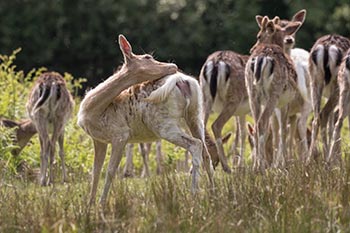Edible Mushrooms - collecting mushrooms for the table
Be very careful when identifying mushrooms and other fungi

look attractive, but they are not edible
Edible mushrooms can be found throughout the New Forest and always offer the prospect of a tasty treat. Many mushrooms and toadstools, however, are confusingly similar in appearance and often require expert knowledge to differentiate one from another.
Furthermore, the naming of mushrooms and toadstools is in some cases variable which simply adds to the potential for confusion:
Latin names for mushrooms and toadstools - and many species do not have 'common' English names - specified in field guides do not always reflect the latest classifications and may therefore differ; common names, when they do exist, are not always mentioned in field guides; multiple common names sometimes apply to individual species; and in some instances different species are referred to by the same common name!
Confusing? Yes, certainly, but there is no need for beginners to be disheartened, for all of this goes with the territory, is part of the fun and challenge of learning about this fascinating wildlife group.
Correct identification, though, provides a wonderful sense of achievement and is absolutely necessary if fungi are collected for the table, for it must always be remembered that some species are unpleasant to eat, others cause gastric upsets of varying degrees of severity, whilst some are highly poisonous and can kill - examples of highly poisonous, deadly species include the frighteningly named Destroying Angel (Amanita virosa) and Death Cap (Amanita phalloides), both of which occur in the New Forest.
Be sure, then, to only eat those species known without any doubt whatsoever to be edible as people have died after eating certain poisonous specimens.
2nd October 2014 update
Public Health England (PHE) said 84 cases of mushroom poisoning have been reported so far this year and the foraging season is only just under way. Last year, PHE's National Poisons Information Service (NPIS) recorded 237 cases of poisoning across the UK, with many involving children under the age of 10.
To be absolutely certain of mushroom identification, access to one or more of the better, specialist fungi field guides and considerable experience are necessary. Guidance from an acknowledged expert is, though, highly recommended - the Forestry Commission, Hampshire Wildlife Trust and the Hampshire Fungus Recording Group periodically organise fungus events which offer opportunities to learn from experts.
Please also be aware that the Crown Lands of the New Forest are a Site of Special Scientific Interest (SSSI) with over two thousand varieties of fungi present, many of which are rare and internationally important. There has, though, been an increase in the 'trend' of foraging in recent years and this increase in popularity of edible fungi picking puts increased pressures on the New Forest, which may have detrimental impacts on the biodiversity of this special place.
For example, people may not be aware that eating fungi picked from the New Forest can lead to rare and endangered species being collected in error. Furthermore, picking impacts on the enjoyment of others who wish to study, admire or photograph fungi in their many forms.
Consequently, the Forestry Commission appeal to people to look, but not pick. (Commercial harvesting is not permitted at all and foray leaders must obtain a licence).
Help me to help you (please)
For those attracted by the idea of collecting food for free (outside the boundaries of the Crown Lands), a number of very useful guides are available to help foragers sort out edible mushrooms from those species best left alone. For availability, check out, for example, the Amazon website, where can also be found customer reviews. Prices there are usually extremely competitive, the ordering process is quick and easy, and delivery is typically fast.
Furthermore - important from my perspective - purchasing anything from Amazon via this link results in the receipt of a modest contribution towards the cost of developing and maintaining this free-to-use New Forest website which, unlike some other similar sites, is not funded by the local Council, the National Park Authority or through any other form of public taxation. (In essence, purchasing via this link costs you nothing and helps ensure that this site will be improved and maintained in the future.)
Quick linksMore links
Other related links
Search this site

Sadly, 58 animals were killed - 35 ponies, 13 cows, 8 donkeys and 2 sheep, whilst a further 32 were injured - 3 pigs, 9 donkeys, 11 cows and 9 ponies.
(Forty-three accidents occurred in daylight, 15 at twilight and 101 in the dark. Twenty-seven accidents were not reported by the driver involved).
Here's just one horrific example - Three donkeys killed in collision with van at notorious New Forest blackspot (Advertiser and Times)


Sika deer continue to engage in rutting behaviour, and will do so until December.
Pigs seek out the remains of the acorn crop.
Beech leaves are transformed into a magnificent mosaic of glorious reds and golds. Other deciduous trees, too, take on an autumnal cloak before their leaves fall.
Dragonflies can occasionally be seen on the wing on bright days early in the month.
December
Foxglove leaves survive the winter at ground level, and offer the prospect of colourful summer blooms to come.
Redwings and fieldfares, autumn and winter visitors, gorge on haws and holly berries.
Great grey shrikes and hen harriers hunt over the heaths and other open spaces.
Honeysuckle by the end of the month often shows welcome signs of new growth.

